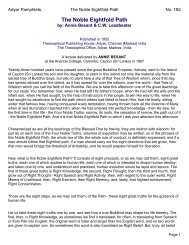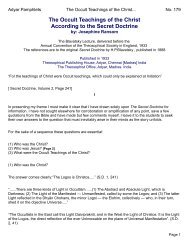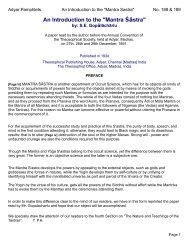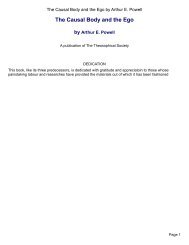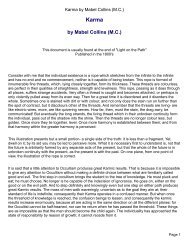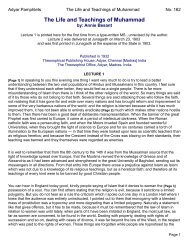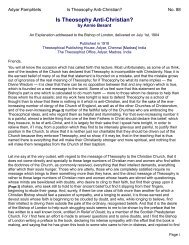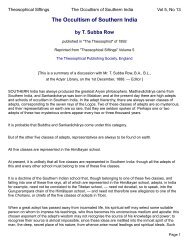The Theosophical Seal - Canadian Theosophical Association
The Theosophical Seal - Canadian Theosophical Association
The Theosophical Seal - Canadian Theosophical Association
You also want an ePaper? Increase the reach of your titles
YUMPU automatically turns print PDFs into web optimized ePapers that Google loves.
<strong>The</strong> <strong>The</strong>osophical <strong>Seal</strong> by Arthur M. Coon<br />
THE CROSS<br />
EVERYTHING which we said about the Square could as truly be said about the Cross, although with<br />
certain significant differences. Like the square, the numerical value of the cross is 4. <strong>The</strong> cross divides<br />
the circle into four equal segments, the day into four parts and the year into four seasons. It marks off<br />
sidereal space into four cardinal points: North, East, South and West. Like the square it is definitely<br />
linked with the physical universe and in that sense with time and space. It also types man as a<br />
personality within a physical body as distinct from soul or spirit. However, the underlying difference in the<br />
philosophy of the Square and the Cross, it seems to me, lies in the distinction between the static and the<br />
dynamic, between finality and infinity.<br />
THE PHILOSOPHY OF THE CROSS<br />
<strong>The</strong> square types a universe which is evolving towards a state of perfection,a state, however, which is<br />
fixed and final. It represents a creation which is ever in the process of becoming or moving towards a faroff<br />
ideal. Religion envisages a goal towards which each one of us, and humanity as a whole,is travelling.<br />
Its prophets and seers envision a perfect society which will one day appear on earth, and such<br />
expressions as a "new heaven and a new earth", the "New Jerusalem", etc., have caught the imagination<br />
of poet and preacher. This idea of existence is, unless one be an out and out materialist, the rational view<br />
of things. Even the most pessimistic among us must accept evolution as a progressive movement<br />
towards a newer state, although he may deny a goal or a direction. Some perplexing questions puzzle<br />
the open mind: Is this goal the end Is this state of perfection final Does this Utopia, once realised,<br />
remain throughout eternity as a blissful state in which struggle, change, progress is unknown Does<br />
evolution reach a goal, however distant, and then cease forever<br />
We visualise the square as the symbol of an ideal manhood which is the ultimate goal of the human race.<br />
And yet this ideal or prototype, far ahead as it is, contains a sense of finality. Once it is attained, it is<br />
finished, complete. <strong>The</strong> history of the human race becomes a series of tableaux in life's natural museum,<br />
each tableau a little nearer to the idea of perfection, which in the progression of time will ultimately be<br />
attained. <strong>The</strong> square, as the symbol of this ideal of perfection, is both its measure and its limitation.<br />
Nothing can be beyond perfection,unless by some metamorphosis the nature of the thing be changed,<br />
and a new idea of perfection be established. <strong>The</strong> concept of perfection implies an end or completion.<br />
Like the square, the cross is the symbol of the universe; but of a universe in which God is immanent in<br />
every star and every atom. It is the symbol of man, both collectively as humanity and individually as a<br />
personality; yet of man within whose body is buried a fragment of Deity. <strong>The</strong> cross is particularly the<br />
symbol of the form side of Nature, but it is also the symbol of the life imprisoned within that form. This<br />
distinction can be graphically illustrated by making a simple little drawing. First we draw a square. Now<br />
assuming this square to be a cube, we proceed to open it up as one would a cardboard box. We draw a<br />
square above the first one to represent the top of the box. <strong>The</strong>n we trace a square on each side of the<br />
original one. <strong>The</strong>se will be the sides opened out. Finally we spread out the front and the bottom by<br />
placing two squares beneath the central one. What we now have is the cube unfolded in the form of a<br />
Latin Cross- symbol of the form unfolded to release the imprisoned life, symbol also of man unfolding his<br />
inherent divine nature.<br />
Page 34



